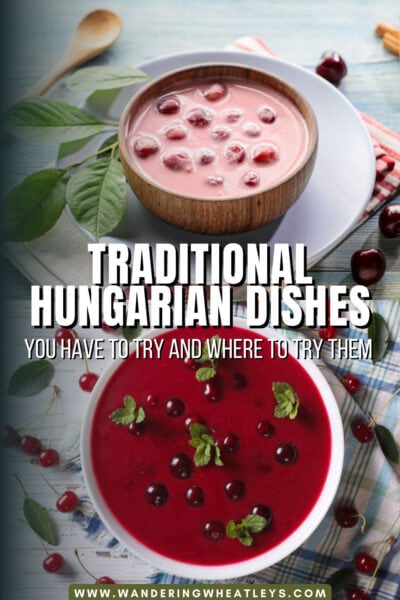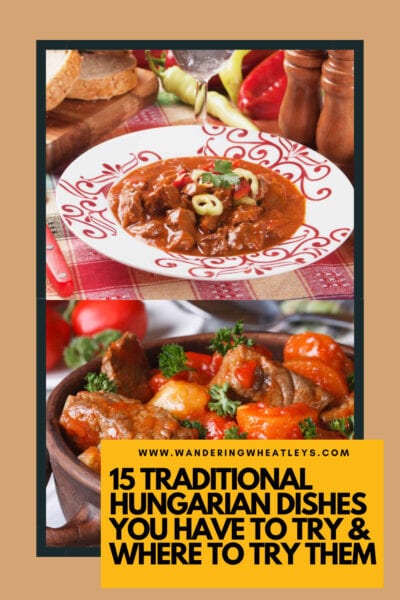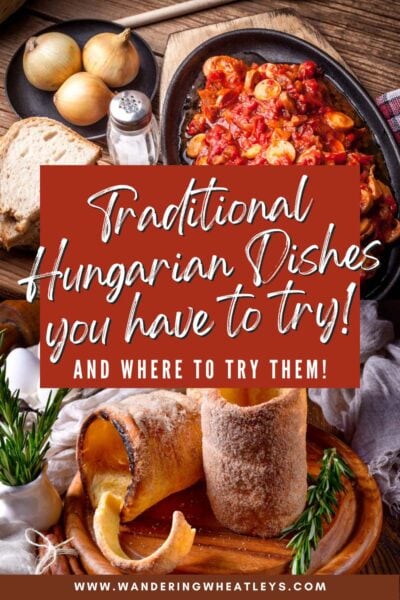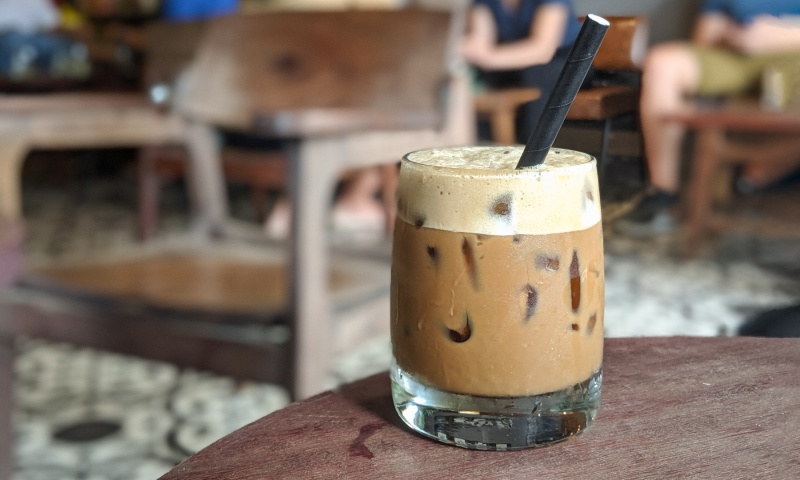Chimney Cakes smothered in cinnamon and bread bowls filled with Goulash will be your sweet and savory introduction to typical Hungarian food. Throw in Chicken Paprikash, a thick Pörkölt stew, and the fiery Fisherman’s Soup, and you’ve got yourself a national cuisine that’s never short of heartiness or spice.
Prepare yourself for a paprika frenzy when you’re traveling in Hungary because Hungarian chefs are more than liberal in their use of this capsicum-based spice. Paprika is much milder than many chili and pepper powders found elsewhere, but still, Hungarian dishes are known to be some of the spiciest in Europe.
Traditional Hungarian cuisine speaks of the nomadic Magyar past of old when cattle herders roamed the Central European Steppe. Think soups, stews, and meat – dishes that could be prepared using ingredients carried on horseback.
Of course, modern Hungarian cuisine is much more nuanced, with sides of Lecsó (a tomato-based ratatouille), snacks of deep-fried Lángos (a pizza-like flatbread), and plates of Nokedli (Hungarian noodles or dumplings) adding to the national palate’s diversity.
With so many dishes to try, you might not know where to begin. That’s why we’ve compiled our list of the absolute best things to eat in Hungary for you. Give these unique Hungarian dishes a try, and there’s no doubt you’ll have an unforgettable time eating your way around this gorgeous European country.
Disclaimer: This post may contain affiliate links. If you make a purchase or booking through one of our links we may earn a small commission (don’t worry, it’s at no extra cost to you).
15 Traditional Hungarian Foods to Eat in Hungary (And Where to Eat Them)
1. Fill up with a hearty Hungarian Goulash
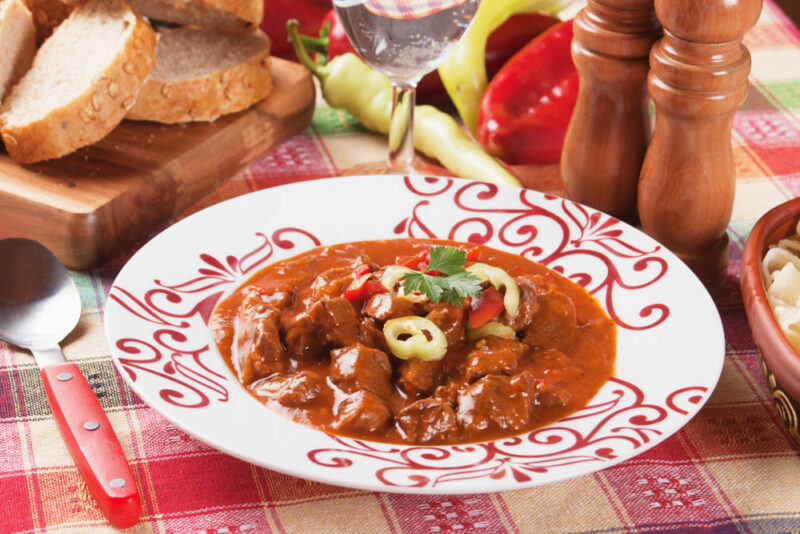
You can’t visit Hungary without filling up on Goulash. This meat and vegetable stew is more than a Hungarian national dish, it’s an enduring symbol of the nation’s culture and identity, and you’ll love the strong flavors and hearty constitution when you’re busy exploring Hungary.
Your typical Goulash is prepared using a base of beef, slow-cooked in a broth alongside carrots, peppers, potatoes, and other seasonal vegetables. The broth is spiced up with the addition of paprika (another Hungarian classic), and it’s often cooked with Hungarian-style dumplings or served in a large, hollowed-out bread bowl.
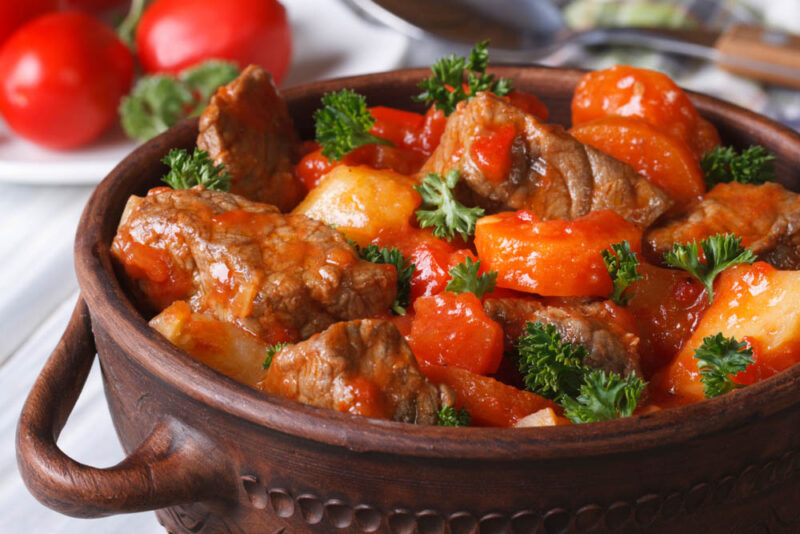
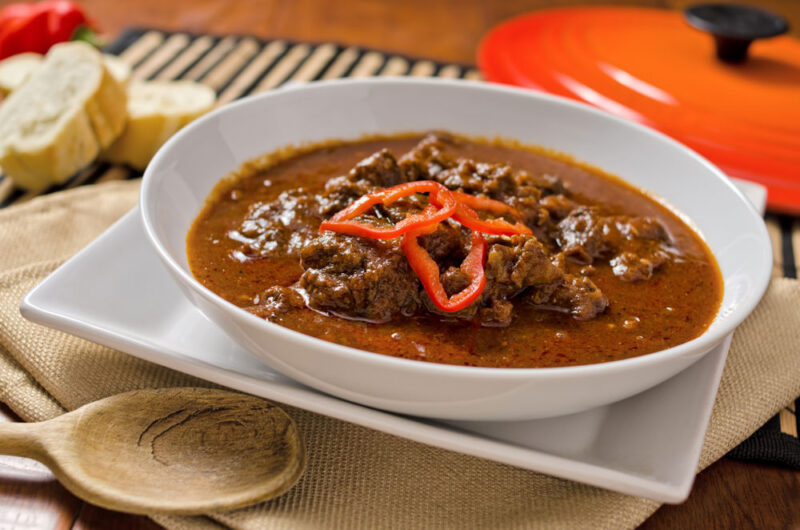
The word Goulash comes from the old Hungarian term Gulyás, which means a “cattle-herder.” The stew evolved on the Hungarian Steppes when the first Hungarian nomads began settling in Central Europe. The cattle herders would prepare Goulash using dried beef and foraged vegetables – a simple but wholesome dish that was perfect for a life outdoors.
Goulash can be found all over Hungary (and indeed, all over Central Europe). No two recipes for Goulash are ever truly the same, and you’ll find that wherever you travel, every chef has their own take on the dish. Budapest has the best selection of Goulash restaurants in the country, with Getto Gulyás being a firm favorite on the Goulash circuit. Szeged, in the south of Hungary, is also known for its pork and sauerkraut take on the traditional Goulash recipe.
2. Enjoy the simplicity of Pörkölt
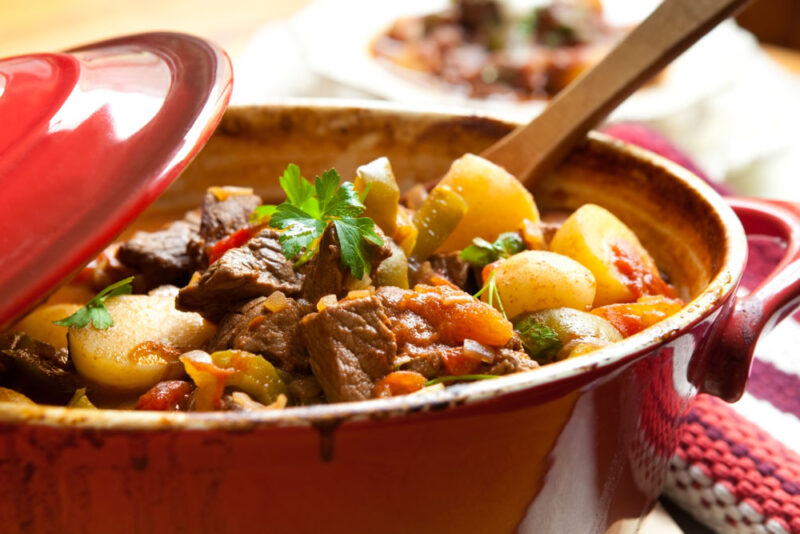
Pörkölt is your typical Hungarian food. It’s hearty, wholesome, and filling, and it’s guaranteed to warm you up on a cold winter’s day or fuel you up for summer sightseeing. Pörkölt is a type of thick stew, and like many Hungarian dishes, it’s prepared with a base of meat, vegetables, and paprika.
To the uninitiated, that might sound a lot like Goulash, which is arguably Hungary’s most famous food. Don’t be fooled, though, because while Pörkölt shares many of the same ingredients, it’s also much simpler and much less soupy.
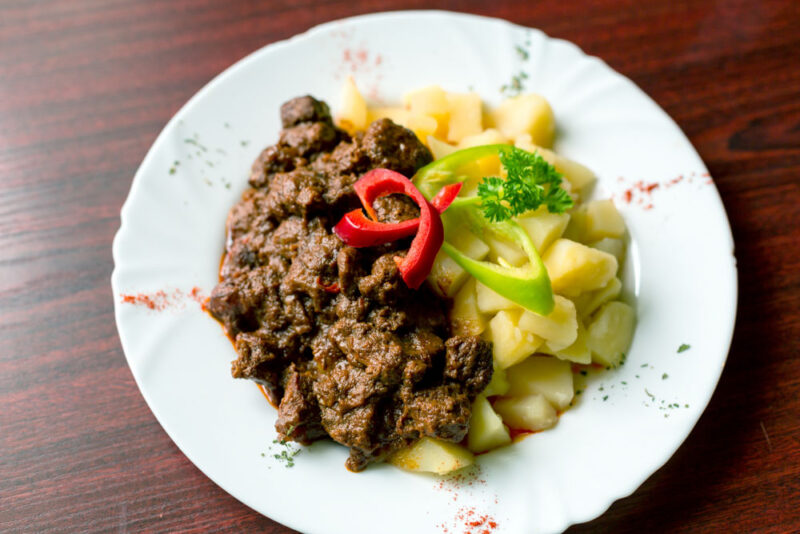
Pörkölt consists of boneless meat (usually beef) prepared in a thick, gravy-like sauce that’s flavored with paprika and served with vegetables. The difference between Pörkölt and Goulash lies in the thickness of the sauce (Goulash is more of a soup) and the fact that Pörkölt is best served with fewer, rather than more, ingredients and spices.
Like Goulash, you’ll find Pörkölt on the menu of almost any Hungarian restaurant in the country. Budapest has a fine selection of Pörkölt eateries, but head to the Central Market Hall to try this national dish in its simplistic glory.
3. Fall in love with Chicken Paprikash
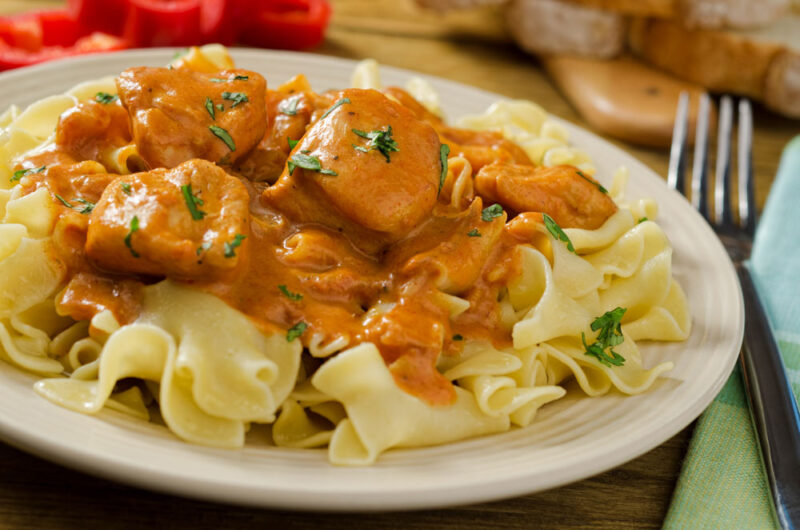
There are many traditional Hungarian foods that you’ll fall in love with, but none so quickly as Chicken Paprikash. This is a dish that you’ll find on all dinner tables, and it’s prepared using chicken cooked in a thick, creamy Paprikash sauce.
Unsurprisingly, this Hungarian classic is prepared using a spicy base of paprika, but it’s also somewhat sweeter in taste than other Paprikash dishes of a similar style. That’s because the best type of paprika to use is prepared from sweeter peppers, rather than spicier peppers. Any fierceness is also mellowed out by the hearty sour cream and tomato mix that makes for a fantastic sauce.
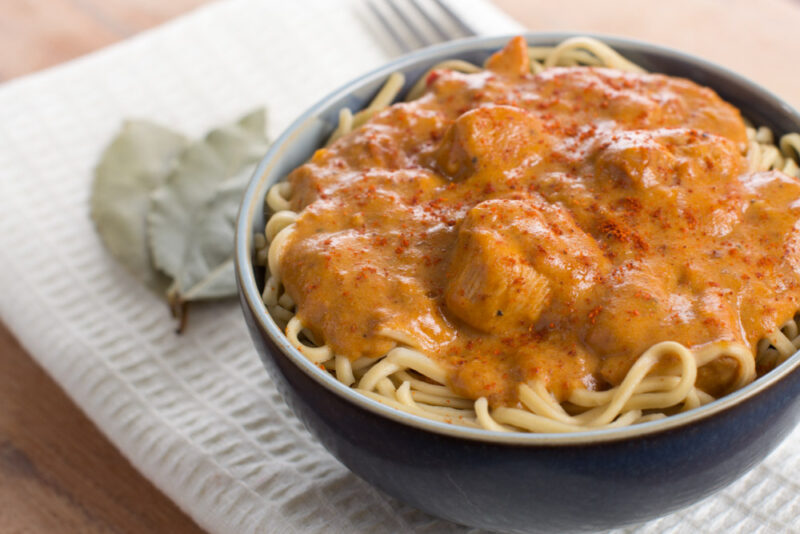
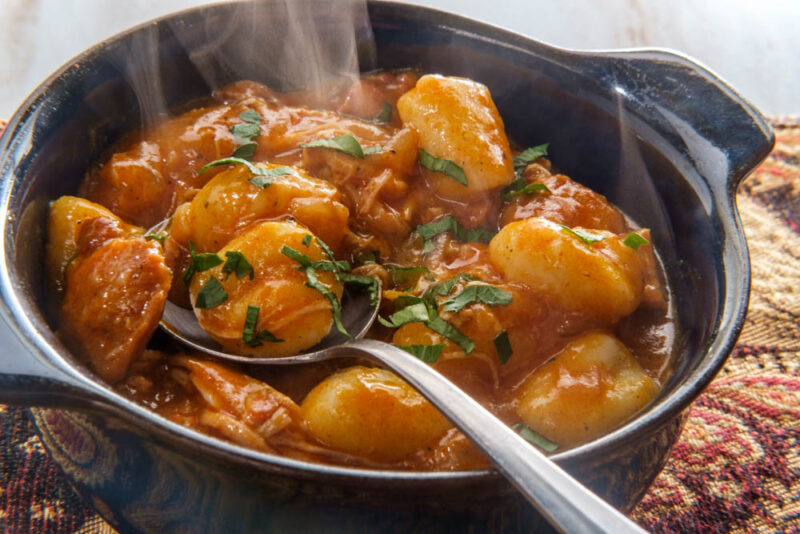
The chicken is first cooked in a pan, then left to simmer in the Paprikash sauce until it’s tender. Once cooked, you can serve it with a side of Hungarian Nokedli (a type of pasta noodle). There are many excellent Chicken Paprikash restaurants in Budapest, including Magyar QTR, Retek Bisztro, and the Central Market Hall.
4. Set your taste buds on fire with a spicy bowl of Fisherman’s Soup
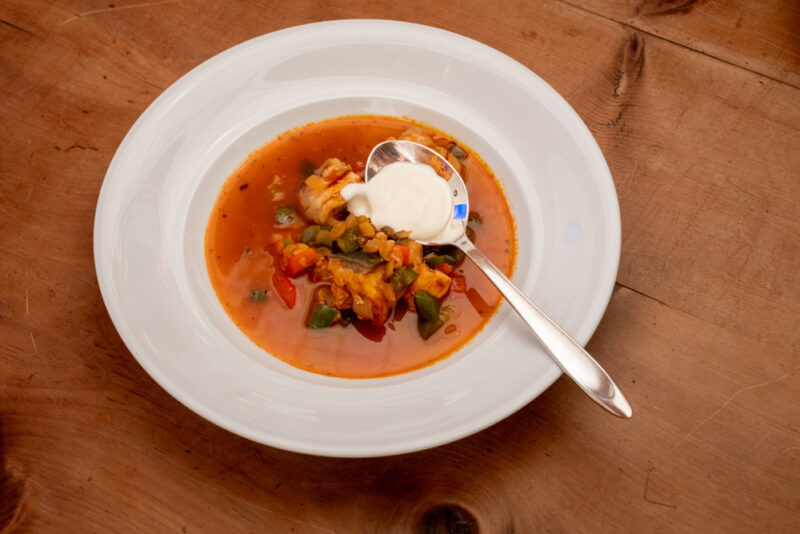
One of the best dishes in Hungary is Fisherman’s Soup, a hearty, warming, and filling soup that was traditionally prepared by Hungarian fishermen. The fishermen would stew their leftover catch in kettles or pots over an open fire, and typically, they’d throw in everything – including the heads and tails.
But arguably, the most important ingredient wasn’t even the fish, but the spices. As with any Hungarian national dish, Fisherman’s Soup is prepared using copious amounts of paprika. The spice level is often upped further with the addition of chilies and chopped peppers, and Fisherman’s Soup has the reputation of being one of Europe’s spiciest dishes.
First, you make the spicy broth base in your pot. Next, add the vegetables and fish, with popular native species being perch, carp, and catfish. The ingredients are then slow-cooked for up to two hours in the broth, leaving you with a spicy, fishy soup.
In Hungary, you’ll need to ask for Halászlé if you’re looking for Fisherman’s Soup. The best place to try Fisherman’s Soup is, without a doubt, Szeged. Found in southern Hungary, two hours south of Budapest, Szeged has long claimed to be the birthplace of this national favorite.
5. Try Lecsó, Hungary’s take on Ratatouille
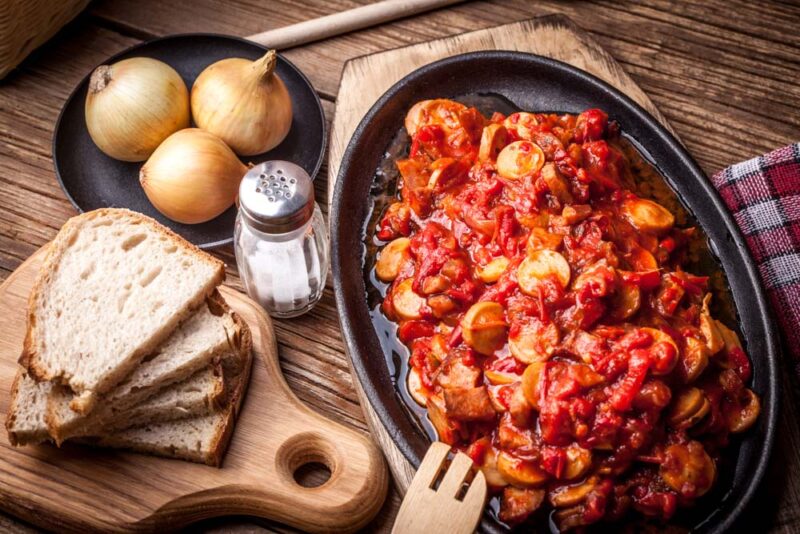
Lecsó is a brilliant Hungarian food that’s best compared to Ratatouille. The similarity is found in the liberal use of vegetables, including peppers, tomatoes, and onions, but the differences are equally profound.
Lecsó is a slow-cooked vegetable medley, and you’ll love how the recipe constantly changes based on the seasons, the availability of produce, and the whims of the chef. Like all traditional Hungarian food, Lecsó stands out from the European crowd thanks to the use of paprika, which is thrown in at every stage of the cooking process.
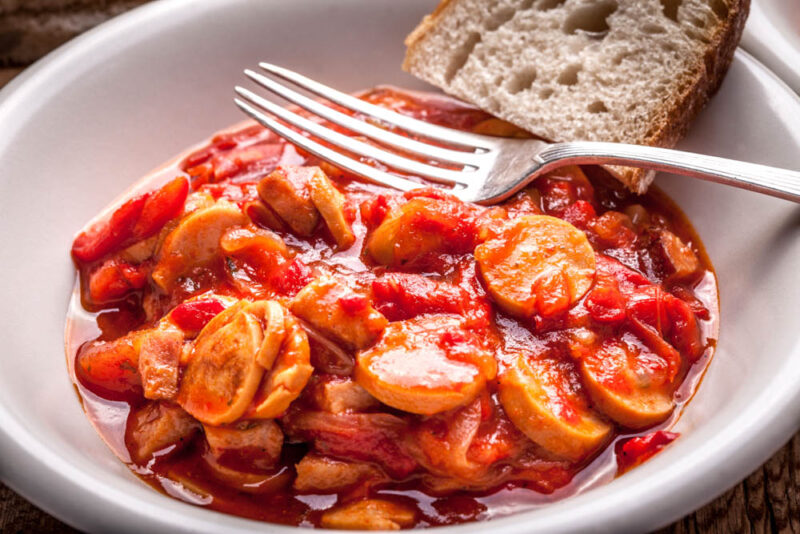
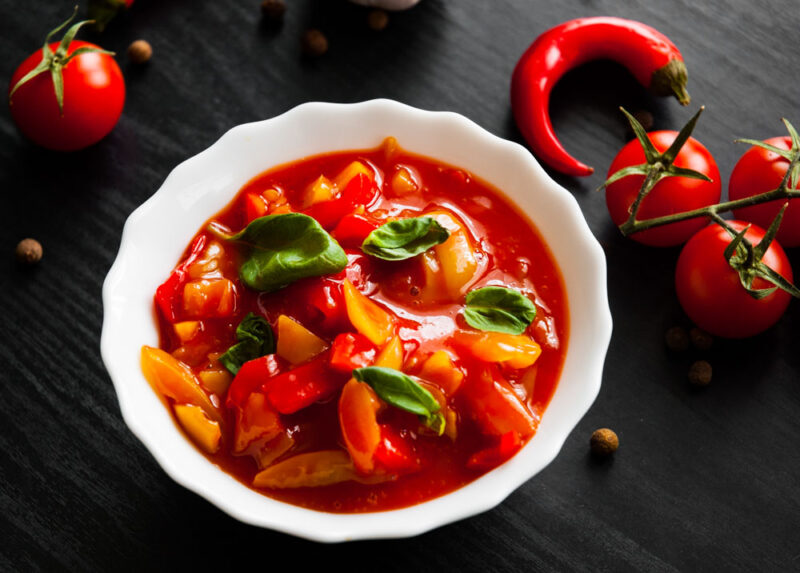
Sweet paprika is the preferred spice, but you’ll also find other spices and seasonings like garlic, salt, and pepper, while even lard or bacon fat is popular. While Lecsó can make for an excellent vegetarian option, be warned that many restaurants typically serve it with meat.
Popular meaty additions to the stew include bacon and Hungarian sausages like Debrecener and Kolbasz. It’s also common to see it served with eggs or simply prepared as a side dish. If you’re in Budapest, then Getto Gulyas and Roma Etelbar both serve a mean Lecsó.
6. Indulge in a few Lángos, Hungary’s deep-fried flatbread
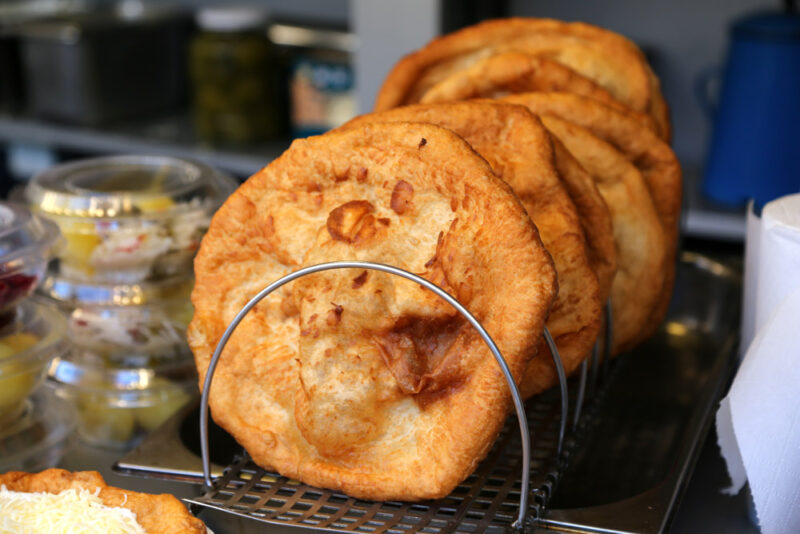
You’ll quickly spot Lángos when you’re walking through Hungarian towns and cities. More accurately, you’ll notice the crisp smell of deep-fried flatbread, particularly if you’re starting to feel a few hunger pangs.
Lángos is a unique street food-style snack that has a long history in Hungary. The word Lángos comes from a Hungarian word for “flame,” and traditionally, Lángos was cooked over an open fire using all the bits of leftover bread from the bakeries. The cooking method has evolved, and today, Lángos are prepared using milk, flour, yeast, and salt, then fried to make the dough rise.
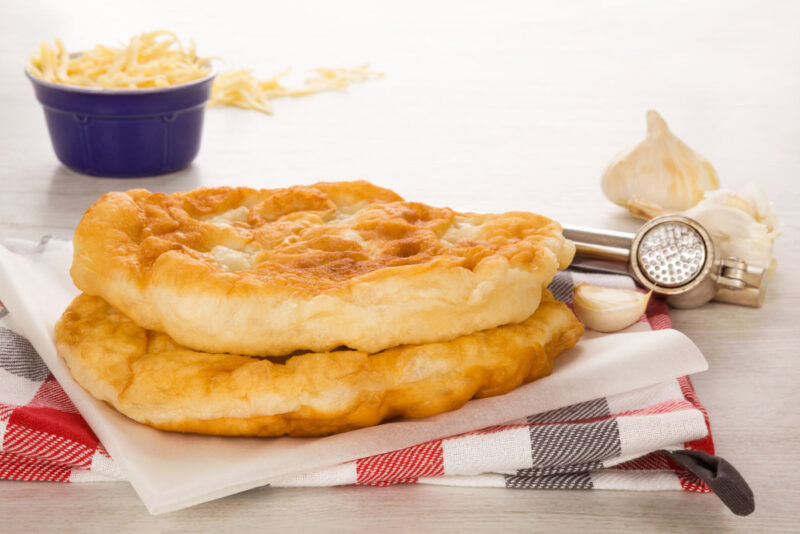
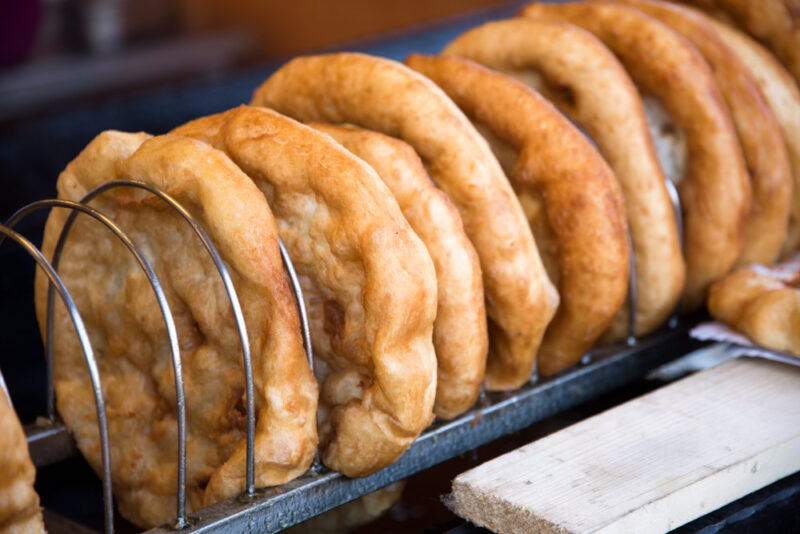
When you first see Lángos, you might mistake it for a pizza. Of course, it’s very different, but the pizza-like texture, shape, and consistency mean that pizza toppings are becoming more common. The traditional toppings are simply sour cream and cheese, but you’ll find everything from ham and jam to eggs and cabbage.
The best Lángos are found on the streets and in the markets. It’s one of those national dishes that you can find anywhere in Hungary, but head to Lángos Land or Street Food Karavan in Budapest for seriously loaded Lángos.
7. Savor the sweet goodness of Chimney Cakes
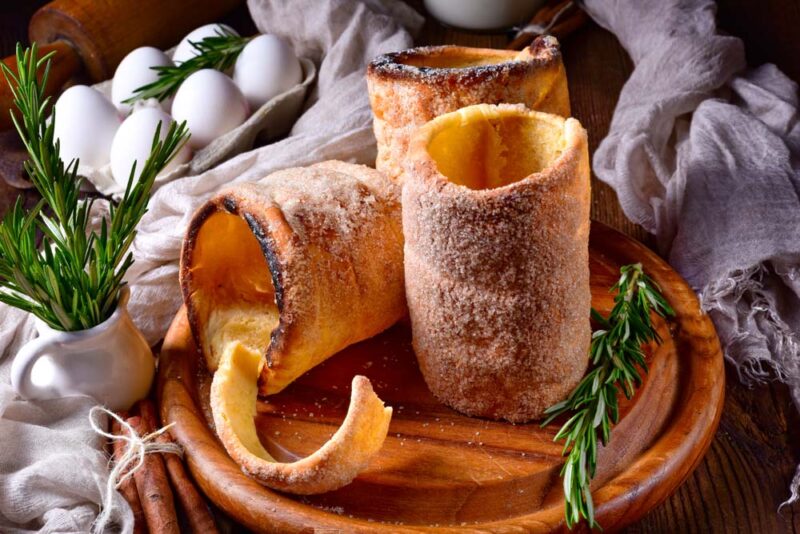
Hungarians are renowned for their use of paprika, but they do have a sweet tooth as well as a palate for the spicy. One of the best sweet Hungarian snacks is the iconic Chimney Cake, or in Hungarian, Kürtőskalács.
Chimney Cakes are so named for their distinctive conical shape that resembles a chimney. It’s prepared using a sweet dough wrapped around a cylindrical stake or stave that’s then baked over an open fire or hot coals. Chimney Cakes are covered in all sorts of tasty toppings, including everything from sugar and jam to Nutella and ice cream.
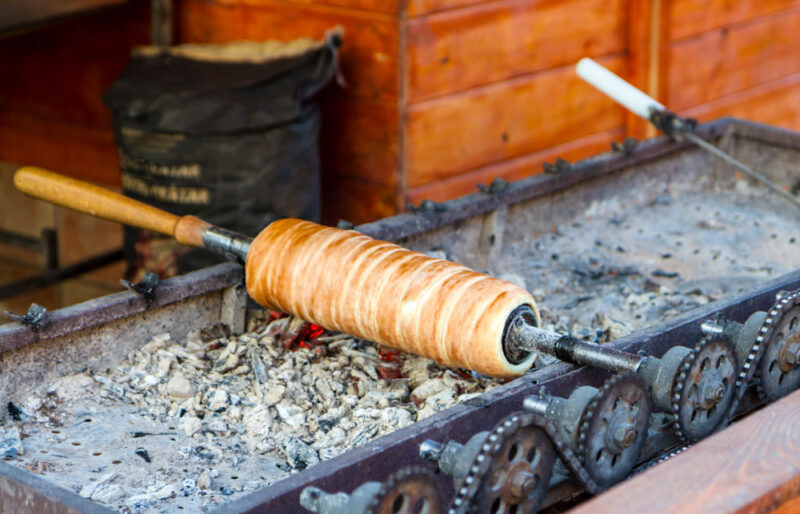

Interestingly, Chimney Cakes are thought to have evolved over the border in Romania, where they’re also incredibly popular. However, they were popular among the Szekelys, a Hungarian-speaking minority who lived within Romania’s borders.
Today, you’ll find Chimney Cakes for sale everywhere in Hungary. They’re particularly popular in winter when you’ll find them being cooked over open coals at Christmas Markets (head to Budapest, of course, for the best Christmas markets in Hungary!).
8. Order a Plate of Töltött Káposzta (Hungarian Cabbage Rolls)
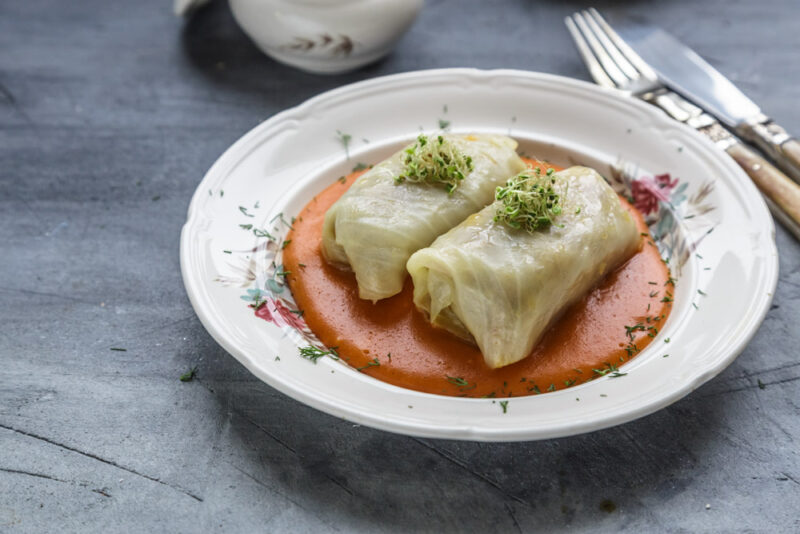
If you want to try your luck at speaking Hungarian, then why not try ordering a plate of Töltött Káposzta? The English translation would be “Cabbage Rolls,” and they’re a delightfully flavorsome dish that’s guaranteed to have you ordering seconds.
Like many of Hungary’s very traditional dishes, Töltött Káposzta is seemingly simple. They’re effectively just cabbage leaves stuffed with a meat or vegetable filling. But different recipes abound across Hungary, and you’ll find that the list of spices and fillings is long indeed.
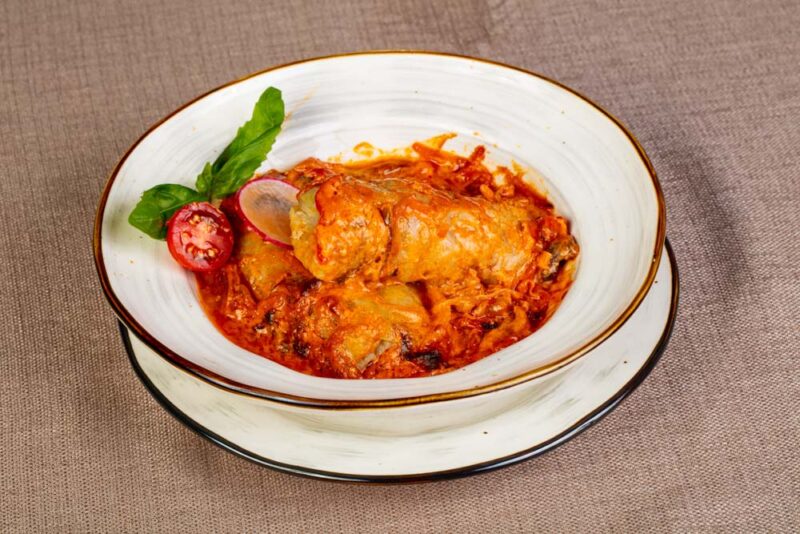
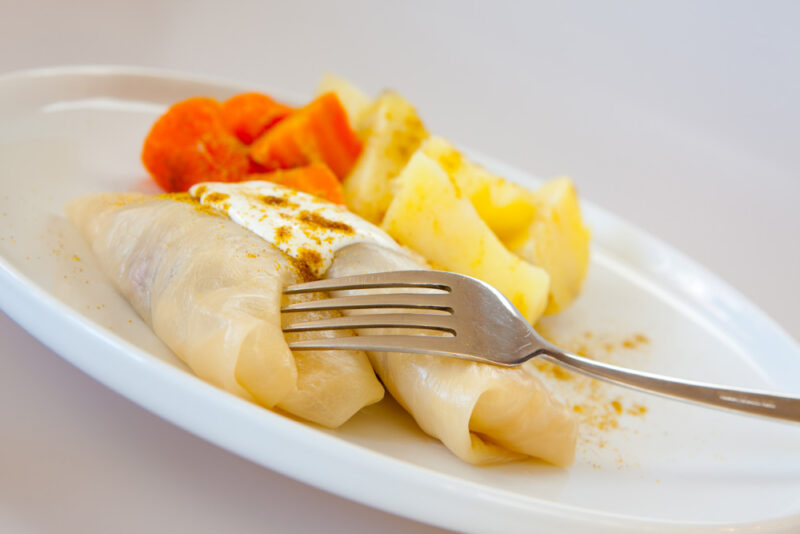
The cabbage rolls themselves are often made from a mixture of fresh cabbage and sauerkraut, which serve as a savory vessel for different meat fillings, often spiced with paprika, salt, and pepper. The meat filling can be pork or beef, or perhaps a mixture, which might then be mixed again with rice, garlic, sausage, and egg.
Once assembled, the Cabbage Rolls are slow cooked until the insides are juicy and the cabbage is beginning to fall softly apart. Serve with sour cream for the tastiest results.
You’ll find delectable Cabbage Rolls for sale in places like the Central Market Hall in Budapest and similar local eateries around the country. However, for a seriously authentic Töltött Káposzta, you’re going to have to get yourself invited to a Hungarian family dinner during the holiday season. Cabbage Rolls are typically served at Christmas and New Year’s (they’re said to bring good luck), and it’s Hungarian home cooks who inevitably prepare the best!
9. Gorge on Nokedli at every meal!
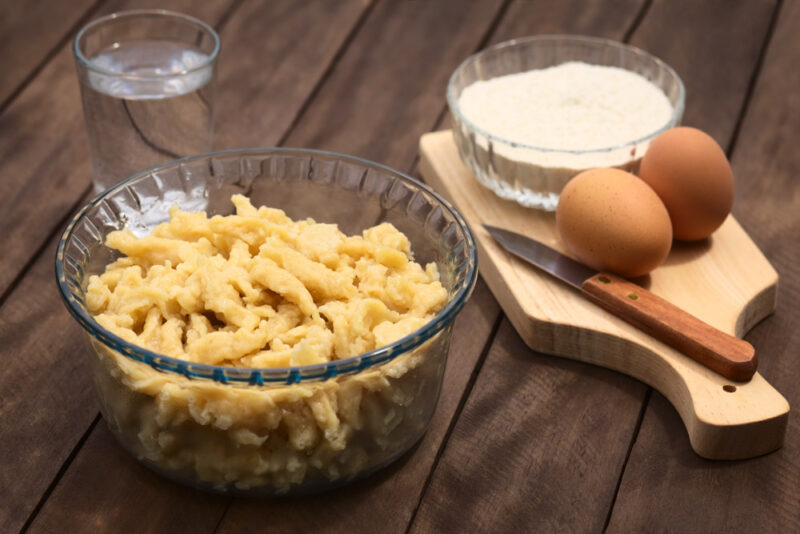
Nokedli is a Hungarian favorite that you’ll become well acquainted with during your travels in the country. This isn’t so much a cuisine but a specific type of food that’s typically served as a side dish or accompaniment.
Nokedli is difficult to define. It looks and tastes a lot like pasta, but English translations will more commonly refer to the dish as “Hungarian dumplings.” You might even see Nokedli translated as Hungarian egg noodles. Whatever the exact translation should be, doesn’t really matter; the translation difficulties simply prove how uniquely Hungarian Nokedli is.
Nokedli is prepared using a basic recipe for dough that consists of flour, water, eggs, and salt. The dough is then grated directly into boiling water, where they take just minutes to set and cook from fresh. Once cooked, the Nokedli is often served as a side to other Hungarian dishes or added to soups and Goulash.
As a side dish, you’ll find Nokedli in all Hungarian restaurants. If you’re a Nokedli super fan, then there are several restaurants in Hungary that treat Nokedli as the main course. In Budapest, for example, there’s Nokedli Bar, and in Visegrad, there’s Nokedli.
10. Have a tipple (or three!) of Pálinka
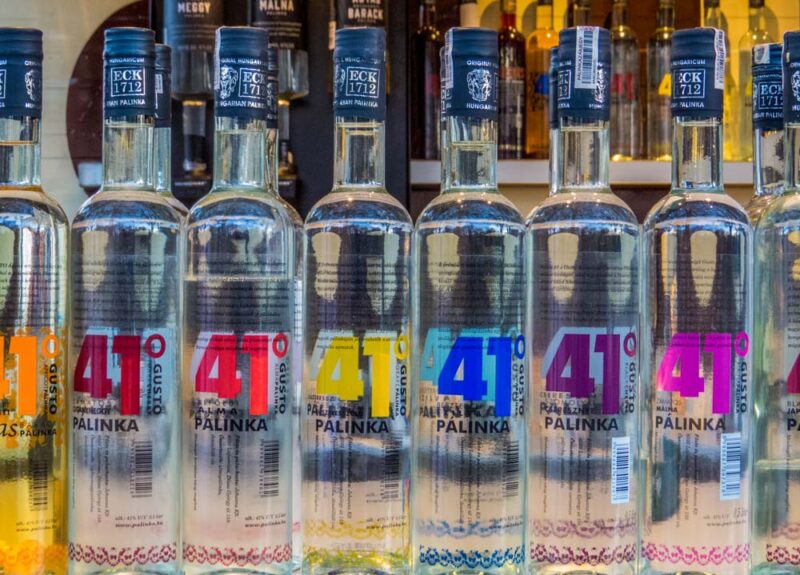
Hungarians distill a mean spirit, and you can’t leave Hungary without trying a tipple (or three!) of Pálinka, which many would consider the national drink.
Pálinka is a brandy-like spirit with a fruity twist to it. The fiery spirit has protected geographical status, which means that Pálinka can only be distilled in Hungary and in certain parts of Austria, where it’s also long been a traditional beverage.
To qualify as Pálinka, the drink has to be distilled from mashed fruits, with popular options including apricot, plum, apple, and cherry. Different varieties of Pálinka might be distilled in copper pots or aged for months at a time before being bottled. The variety is quite something, given the different fruity flavors, so you’ll never get bored drinking Pálinka.
You’ll be offered Pálinka in any Hungarian bar you stroll into. A great way to start learning more about its nuances is with a visit to the House of Hungarian Pálinka in Budapest. Once you’re immersed in the world of Pálinka, you’ll find there’s a National Pálinka Council regulating distillation, annual awards, and national competitions.
11. Lap up the sweet and sour goodness of Hungarian Sour Cherry Soup
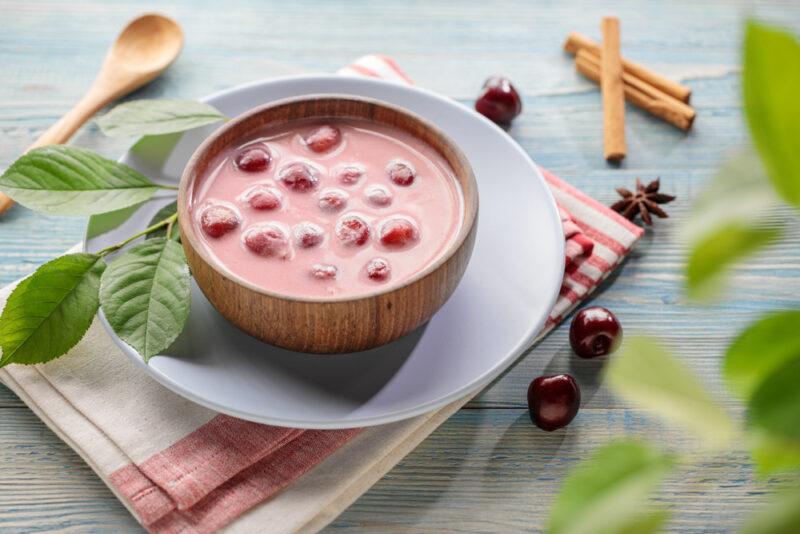
Hungarian Sour Cherry Soup is a seasonal summer delight you’re going to love. When the first sour cherries of the season are ripe for picking, you’ll find the first Sour Cherry Soup being prepared.
The recipe is straightforward, but we love the sweet and sour contrasts that make this dish so delectable. The sour cherries, of course, give this soup a sour tone, but anyone that enjoys “sour” cherries will also know they’re remarkably sweet. The sweetness is exemplified by the addition of cinnamon, clove, or a little sugar, while sour cream tops off the sour flavor throughout.
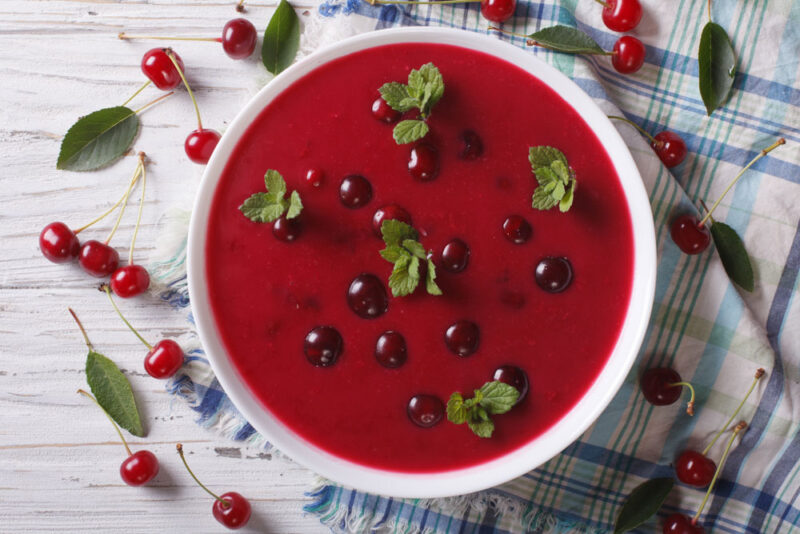
Sour Cherry Soup is always served cold in Hungary. You’ll commonly find it being prepared as a refreshing, fruity appetizer during the hot summer months when it works beautifully as a cooling dinner course.
In season, check for Meggyleves on the specials menu when you’re in restaurants. The best Sour Cherry Soup is found outside the cities, with outdoor hotspots like Lake Balaton serving up plenty of Meggyleves to Hungarian tourists.
12. Enjoy seven layers of Dobos Cake delight
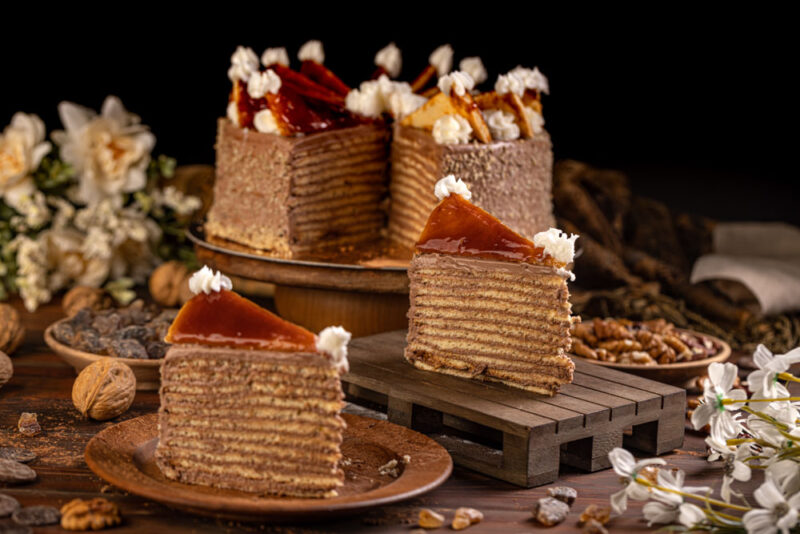
One of the best Hungarian desserts is Dobos Cake, a seven-layered delight that’s been satisfying sweet tooths for over a century.
Dobos Cake (in Hungarian Dobos Torta or Dobosh) is a type of sponge cake that was invented in Budapest and presented by its maker to the Emperor and Empress of the Austro-Hungarian Empire in 1885. The cake is named for Jozsef Dobos, the pastry maker who concocted the recipe in his efforts to create a layered cake that was both intricate, long-lasting, and yet surprisingly easy to prepare.
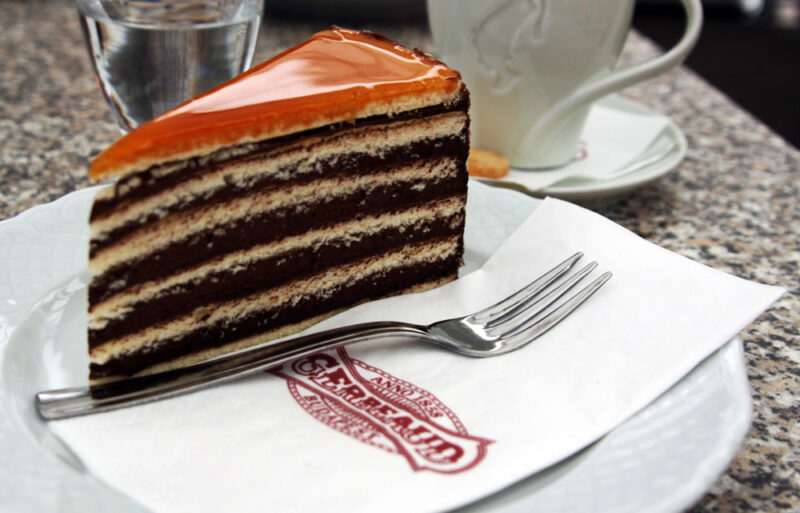
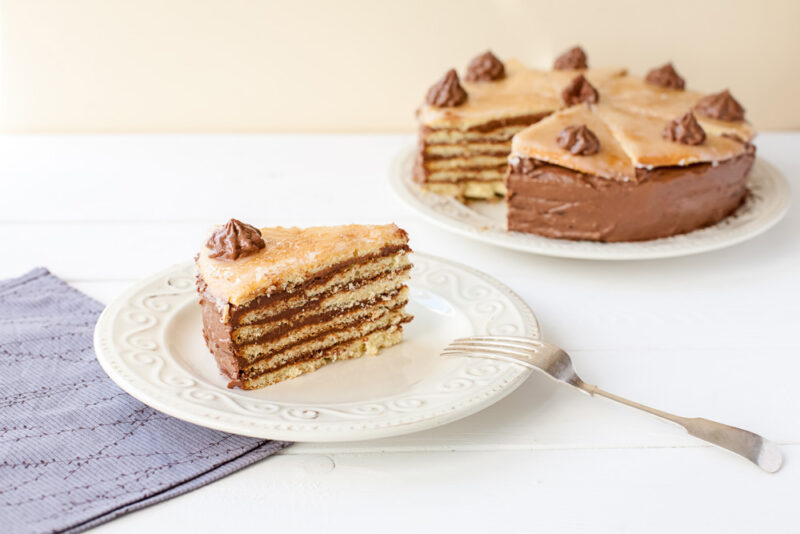
The seven layers of Dobos Cake are now beloved by Hungarians, and the cake is found in bakeries and patisseries across the country. The cake is layered with chocolate buttercream and sponge before being topped with glazed caramel. It might even include a few sneaky almonds or hazelnuts, depending on the pastry chef’s tastes.
As the home city of Dobos Cake, there’s no doubt that Budapest is the center of the Dobos Cake baking world. Head to Gerbeaud Cafe, Ruszwurm Confectionery, or Auguszt 1870 for some great takes on this Hungarian classic.
13. Discover the best sausages in Debrecen
Take a trip to the lesser-visited city of Debrecen if you’re looking for the best Hungarian sausages. Located in the country’s northeastern region, Debrecen was, for many centuries, the largest city in Hungary, and it’s played a huge role in the nation’s culinary development.
Debrecen’s biggest contribution is the Debrecener, a popular type of sausage that (surprise, surprise) is prepared using a heavy dose of paprika. The Debrecener is a pork sausage, and the pork meat is spiced up with paprika, garlic, pepper, and other seasonings before being lightly smoked.
Debrecen sausages can be fried or grilled, and they are often added to other Hungarian dishes, like Lecsó. It goes without saying, but the best Debrecener will always be found in Debrecen!
14. Order Hortobágyi Palacsinta (savory Hungarian pancakes)
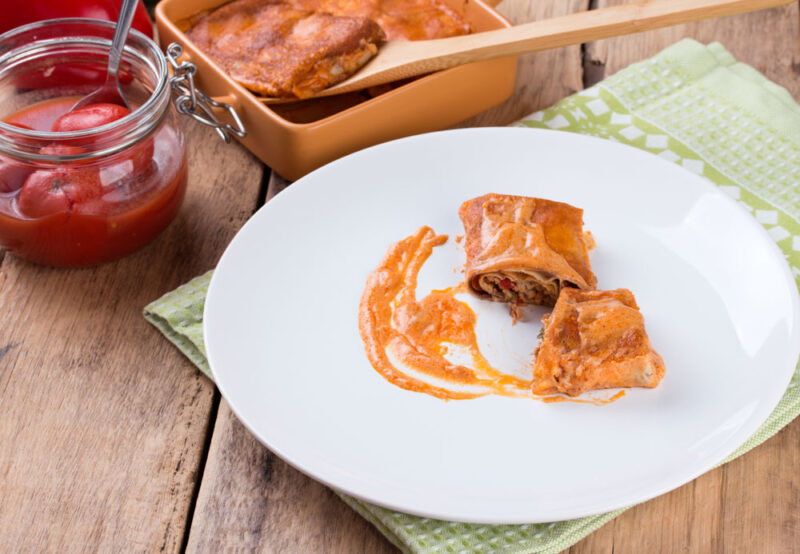
We don’t all have a sweet tooth or dessert cravings, in which case you’ll love an order of Hortobágyi Palacsinta. This is Hungary’s take on the pancake or crepe, but instead of being sweet, it’s very much a savory affair.
Hortobágyi Palacsinta is an incredibly popular Hungarian dish, with the crepes being prepared from a mixture of eggs, flour, and milk. The fillings are absolutely delicious (and varied), with many Hungarian classics, like Pörkölt or Goulash, finding their way inside the rolled-up crepes.
Once filled, Hortobágyi Palacsinta is then baked in the oven before being served with sour cream or paprika sauce (you could almost think of them as a Hungarian-style enchilada, just without the cheese!).
In Budapest, Nagyi’s Creperie serves excellent Hortobágyi Palacsinta, while Nancsi Neni, near Solymar, serves fantastic Hungarian crepes in an old 17th-century farmhouse setting.
15. Try Beigli for a festive treat
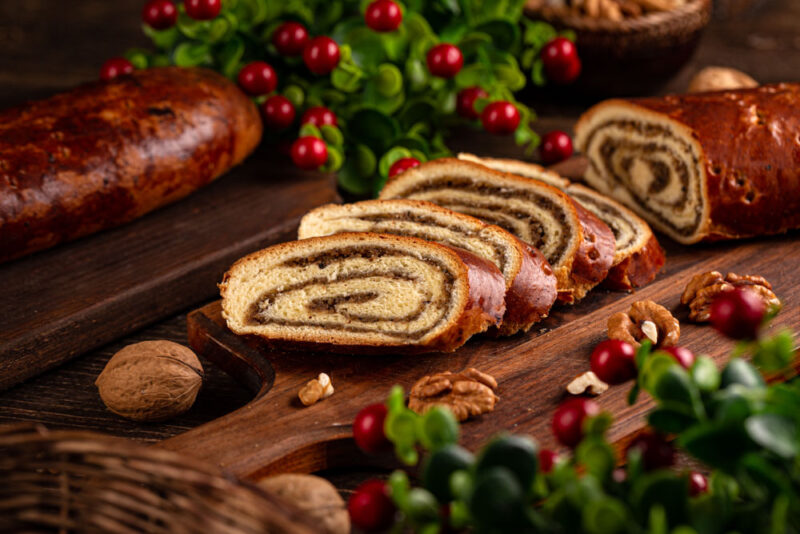
One of Hungary’s most distinctive treats is Beigli, a tasty type of cake that’s traditionally served during the holiday season. Beigli is prepared using a delicious poppy seed or walnut filling encased within a long, sweet pastry exterior.
Beigli is easily recognizable in bakeries, shops, and at Christmas markets. The long roll is sliced into smaller pieces that reveal a unique swirl in the center, with a filling that’s made even more flavorsome with the addition of cloves, cinnamon, and other sweet treats.

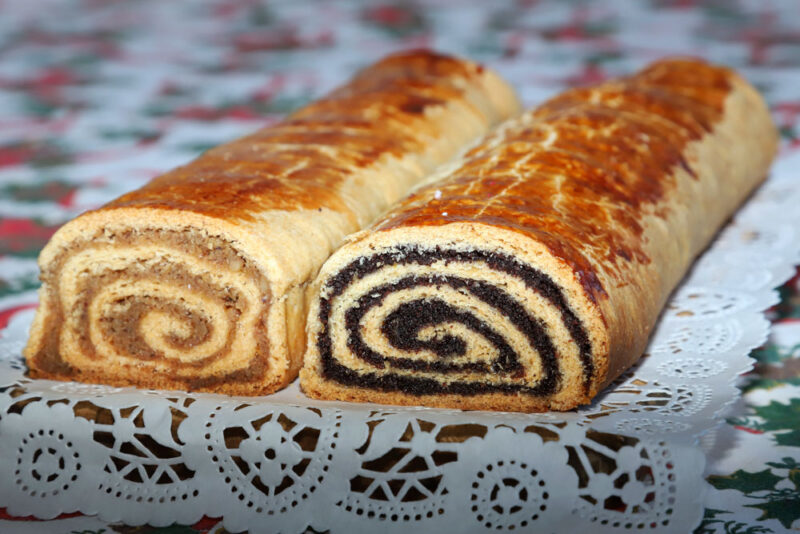
This is a cake that’s often reserved for Christmas, although you’ll also find it prepared during other important festivities, including Easter. Often, you’ll find families preparing one Beigli with a poppy seed filling and another with a walnut filling. The two are then served next to each other for the ultimate holiday delight.
You’ll find Beigli in all good bakeries during festive seasons, with Christmas markets in Budapest and other major cities guaranteed to have plenty of Beigli for sale!
There you have it! The 15 best things to eat in Hungary. What’s your favorite Hungarian Dish?
Planning a trip to Hungary? Check out our favorite books and travel guides!
SHARE THIS ON PINTEREST
